Data extracted in March 2024.
Planned article update: 30 April 2025.
Highlights
Among the European Neighbourhood Policy-South countries for which data is available, GDP per capita in 2022 ranged between €2 810 in Palestine and €52 760 in Israel. In comparison, GDP per capita in the EU was €35 430 in 2022.
Around half of the population was economically active in the European Neighbourhood Policy-South countries in 2022, with rates ranging from 45.1 % in Egypt (2021 data) to 51.5 % in Tunisia. Jordan (33.4 %) and Israel (71.9 %) were the exceptions. In the EU, the rate was 74.5 %.
This article is part of an online publication. It provides data on economic statistics for nine out of the ten countries that form the European Neighbourhood Policy-South (ENP-South) region — Algeria, Egypt, Israel, Jordan, Lebanon, Libya, Morocco, Palestine [1] and Tunisia. Cooperation with Syria is suspended since 2011. Data for Lebanon do not include Palestinian refugee camps.
This article presents, among others, statistics on the gross domestic product (GDP), measured in € and in € per person; the size of the labour force compared to the total population of working age; the contributions of the respective main (non-financial) economic sectors to total employment and gross value added (GVA); the gross fixed capital formation in these economies; the trade balances of goods and services with the rest of the world from the balance of payments statistics; foreign direct investments (FDI) flows; and the number of persons employed by the public and private sectors.
Gross domestic product (GDP)
Gross domestic product (GDP) is an aggregate measure of the size of an economy, based on its total final output. The estimated combined GDP of the ENP-South countries was €1.12 trillion according to the latest data available. In comparison, the GDP of the EU was €15.9 trillion in 2022. However, it should be noted that for some ENP-South countries, the most recent data dates back several years.
In 2022, Israel remained by far the largest economy among the ENP-South countries with a GDP of €498.7 billion. The economy of Egypt generated a GDP of €172.7 billion in 2017, the latest year for which data are available. In 2021, Algeria's GDP was €138.2 billion, lower than the GDP recorded prior to the Covid-19 pandemic; 2022 data are not available. Morocco’s economy reached €124.5 billion in 2022, with only a dip in 2020 coinciding with the Covid-19 pandemic. Data for Libya is not available after 2019, when its GDP was €61.7 billion. Jordan’s GDP was €43.1 billion in 2021, compared to €39.7 billion in Tunisia. The estimated GDP of Lebanon fell to €21.6 billion during the Covid-19 pandemic in 2020. In 2022, Palestine’s GDP was €14.8 billion.
In comparison, the EU's GDP reached €15.9 trillion in 2022.
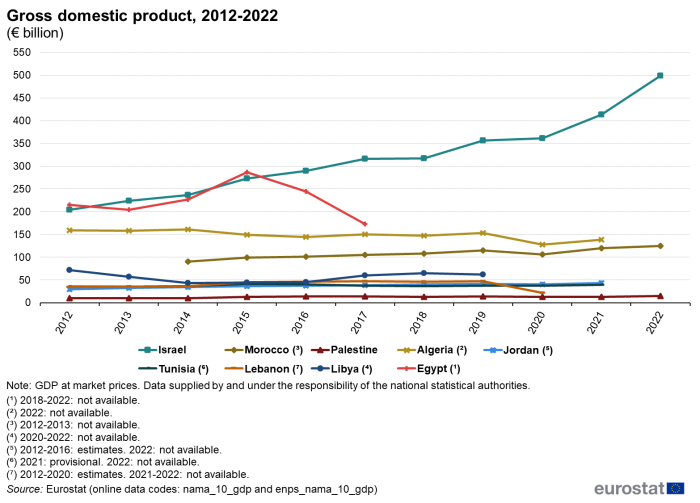
(€ billion)
Source: Eurostat (nama_10_gdp) and (enps_nama_10_gdp)
Real gross domestic product, also called GDP at constant prices, focuses on the volume of output, ignoring price changes. The calculation of the annual growth rate of GDP at constant prices, in other words the real change in GDP, allows comparison of the dynamics of economic development, both over time and between economies of different sizes, regardless of developments in price levels and exchange rates.
Data on annual change in real GDP are shown in Figure 2 for the period 2018-2022. In 2019, immediately before the Covid-19 pandemic impacted economies, annual real GDP growth was highly disparate in the ENP-South countries with 3.8 % in Israel, 2.9 % in Morocco, 1.8 % in Jordan, 1.5 % in Tunisia, 1.4 % in Palestine, 1.0 % in Algeria, -6.9 % in Lebanon and -11.9 % in Libya, compared with a real GDP growth of 1.8 % in the EU. The year 2020 marked the start of the economic impact of the Covid-19 pandemic. All ENP-South countries and the EU recorded a decline in real GDP in that year. Among the ENP-South countries for which data is available, the largest fall was in Lebanon at -25.9 %, followed by Palestine at -11.3 %, Tunisia at -8.6 % and Morocco at -7.2 %, all larger than the -5.6 % decline in the EU. In 2020, real GDP fell at a slightly lower rate than in the EU in Algeria (-5.1 %), Israel (-1.5 %) and Jordan (-1.1 %).
Although the Covid-19 pandemic continued into 2021, the economies of the ENP- South countries and the EU rebounded strongly. Israel’s real GDP growth in 2021 was 9.3 %, Morocco’s growth stood at 8.0 % and Palestine’s at 7.0 %, which were all greater than the growth in the EU (6.0 %). There was slower growth in Tunisia, at 4.3 %, Jordan, at 3.7 %, and Algeria, at 3.4 %.
For 2022, only Morocco’s, Israel’s and Palestine’s data are available for ENP-South countries. Israel still experienced a substantial growth of 6.5 % in real GDP. It was closely followed by Palestine with 4.1 %. In contrast, real GDP increased more moderately in Morocco, with a growth of 1.3 %.
In 2022, real GDP grew by 3.5 % in the EU, 2.5 pp lower than the previous year.
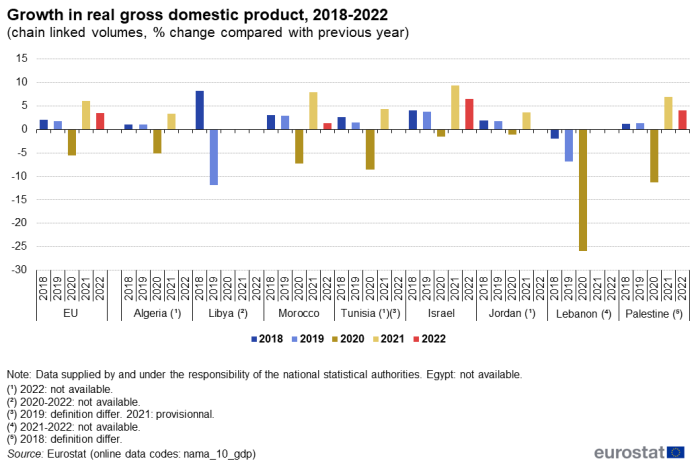
(chain linked volumes, % change compared with previous year))
Source: Eurostat (nama_10_gdp)
Analysis of GDP per capita (per person) removes the influence of the population size, making comparisons between different countries easier. GDP per capita is a broad economic indicator that may be used for a basic analysis of living standards. However, measured in GDP at market prices, this measure does not consider differences in price levels between countries.
As shown in Table 1, GDP per capita increased from 2021 to 2022 for the EU, Israel, Morocco and Palestine, and from 2020 to 2021 for Algeria, Jordan and Tunisia (2022 data not available). For Lebanon, Libya and Egypt, recent data are not available.
The highest GDP per capita among the ENP-South countries was recorded in Israel in 2022, at around €52 760 per inhabitant, far higher than in every other ENP-South country and higher than the EU average. In the other ENP-South countries for which recent data are available, the GDP per capita in 2022 was more comparable across countries, ranging from €2 810 in Palestine to €3 890 in Jordan (2021). The GDP per capita of Algeria (€3 100; 2021), Tunisia (€3 370; 2021) and Morocco (€3 390) also fell within this range.
For the countries with less recent data, GDP per capita in Lebanon was estimated at around €9 610 in 2018, while it was around €9 130 in Libya in 2019. For Egypt, the most recent data showed a GDP per capita of €1 820 in 2017, well below the other ENP-South countries.
In comparison, GDP per capita in the EU averaged €35 430 in 2022
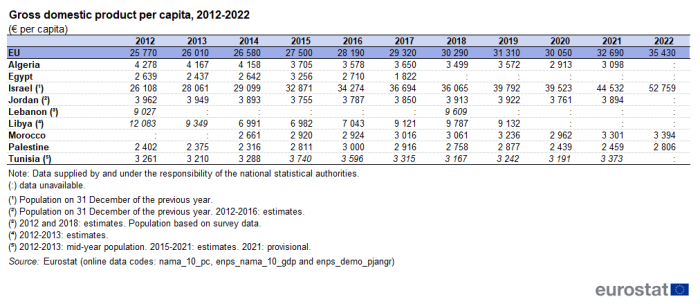
(€ per capita)
Source: Eurostat (nama_10_pc), (enps_nama_10_gdp) and (enps_demo_pjangr)
Labour force
The labour force consists of the economically active population. It includes both employed and unemployed persons, while the economically inactive population is composed, among others, of students, pensioners, persons caring for other family members and those who are unable to work because of long-term sickness or disability. Only the working-age population (15 to 64 years) is considered in the data analysed. A high rate between the labour force and the whole population is considered a pillar to build a stable economy.
Figure 2 shows that, among the ENP-South countries, Israel's total economic activity rate in 2022 was relatively similar to the EU average of 74.5 %, with its labour force making up 71.9 % of its population aged 15 to 64. Other ENP-South countries had economic activity rates of around 50 % in 2022, with only Jordan having a substantially lower rate. Tunisia had an economic activity rate of 51.5 %, just above half of the population of working age, while Morocco (48.9 %; 2021 data), Lebanon (48.8 %; estimated), Palestine (47.1 %), Algeria (46.1 %; 2019 data) and Egypt (45.2 %; 2021 data) had rates below the 50 % mark. Jordan recorded by far the lowest economic activity rate among the ENP-South countries in 2022, at one third (33.4 %) of the working-age population. No recent data on the economic activity rate is available for Libya.
Although the overall economic activity rate was substantially lower in most of the ENP-South countries than in the EU in 2022, this was mainly due to their low economic activity rates for women. Except for Jordan, their economic activity rates for men were relatively close to that of the EU (79.4 %), and similar to each other. Morocco (75.4 %; 2021 data) had the highest rate for men among the ENP-South countries, followed by Israel (73.7 %), Palestine (73.6 %), Lebanon (73.4 %; estimated), Egypt (72.7 %; 2021 data), Algeria (72.6 %; 2019 data) and Tunisia (72.5 %). The economic activity rate for men was 53.1 % in Jordan in 2022.
In contrast, the economic activity rates of women were substantially lower in the ENP-South countries than in the EU (69.5 %), with Israel a notable exception (70.2 %). For Israel, this implied a gender gap for economic activity of 3.5 percentage points (pp), lower than that of the EU (9.9 pp). Among the other ENP-South countries, Tunisia had the highest economic activity rate for women (31.0 %), corresponding to a gender gap of 41.5 in the economic activity rates. For Lebanon, Palestine, Algeria and Egypt, the rates for women ranged from estimated 25.7 % in Lebanon to 16.2 % in Egypt (2021 data), with the corresponding gender gaps ranging between 56.5 pp in Egypt (2021 data) and 47.7 pp in Lebanon (estimated). The lowest economic activity rate for women in the ENP-South region was recorded in Jordan, at 13.9 %. However, due to the low rate also for men, the gender gap in economic activity in Jordan was somewhat lower than in the other countries, at 39.2 pp.
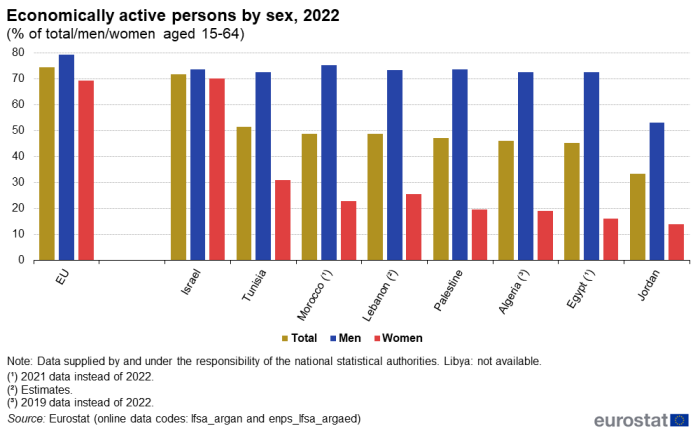
(% of total/men/women aged 15-64)
Source: Eurostat (lfsa_argan) and (enps_lfsa_argaed)
Employment and gross value added by sector
The gross value added (GVA) is the value that producers have added to the goods and services they have bought. GVA is used as an economic productivity metric, measuring the contribution to GDP made by producers, industry or sector to an economy. The comparison between GVA and employment (employed persons aged 15 years and over) by sector gives insights into the profitability of a sector: whereas the ratio of GVA in a sector on the total GVA of the economy is higher than its relative ratio of employment, it can be considered that the sector is profitable, or at least has a higher labour productivity than the average in the non-financial part of the country's economy.
Data are shown in Figure 3. The data generally refer to 2022, with the exceptions of Algeria (2019), Egypt and Morocco (both 2021) for employment, and Algeria, Jordan and Tunisia (all three 2021), Egypt (2017) and Lebanon (2019) for GVA. Data on employment by sector are not available for Jordan, while recent data are not available for Libya.
Most of the employment in the ENP-South countries, as in the EU, was in the 'Services' sector. This sector's share of employment ranged from 45.8 % in Morocco to 83.3 % in Israel. Nevertheless, the 'Services' sector generated higher shares of total GVA than its corresponding shares of employment in most of the ENP-South countries, implying higher labour productivity higher than the average of these main sectors in the respective economy. The shares of the 'Services' sector ranged from 46.4 % of total GVA in Algeria to 79.8 % in Israel. Palestine had the highest labour productivity of the 'Services' sector relative to the average in the economy among the ENP-South countries, with a difference between the sector's share of total GVA (77.4 %) and total employment (61.2 %) of 16.2 pp. Thereafter followed Morrocco with 14.5 pp (60.3 % of GVA; 45.8 % of employment) and Tunisia with 7.9 pp (64.4 % of GVA; 56.5 % of employment). The only two countries where 'Services' had lower labour productivity than the average in the economy were Algeria, with -14.4 pp, and Israel, with -3.5 pp.
In some ENP-South countries, the 'Agriculture, forestry and fisheries' sector accounted for a relatively high share of employment, with shares of 31.2 % in Morocco and 19.2 % in Egypt. In Tunisia (11.5 %), Algeria (9.6 %) and Palestine (6.2 %) the share were relatively lower while in Lebanon (4.1 %) and Israel (0.8 %) this sector's share of employment was closer to or below the EU share of 3.7 %. The highest shares of the 'Agriculture, forestry and fisheries' sector in total GVA was in Algeria (12.6 %), Egypt (11.7 %), Morocco (11.4 %) and Tunisia (10.9 %), with shares lower than 10 % in the other countries. In Morocco (-19.8 pp) and Egypt (-7.5 pp), this sector had a considerably lower labour productivity than the economy overall, while in Lebanon (4.2 pp) and Algeria (3.0) it was higher than the average in the economy. For the other countries, the difference in the 'Agriculture, forestry and fisheries' sector's shares of GVA and employment was between -0.6 and 0.5 pp.
Concerning the 'Construction' sector, it only had a share of GVA above 10 % in Algeria (12.1%). In the other countries, the sector's share of GVA ranged from 6.3 % in Israel to 2.6 % in Lebanon. With respect to employment, the 'Construction' sector had a share between 18.8 % in Palestine to 5.2 % in Israel. Israel was the only country in which the labour productivity of the 'Construction' sector was higher than in the non-financial economy overall (1.1 pp). In all the other ENP-South countries it was lower.
In the EU, the main sectors 'Industry' (20.6 % of total GVA, compared with 17.7 % of total employment; difference 2.9 pp) and 'Services' (71.9 % of GVA, compared with 71.5 % of employment; difference 0.4 pp) had a higher labour productivity than the average in the total non-financial economy. For 'Construction' (5.5 % of GVA, compared with 6.7 % of employment; difference -1.2 pp) and 'Agriculture, forestry and fisheries' (1.9 % of GVA, compared with 3.7 % of employment; difference -1.8 pp), it was lower than the average.
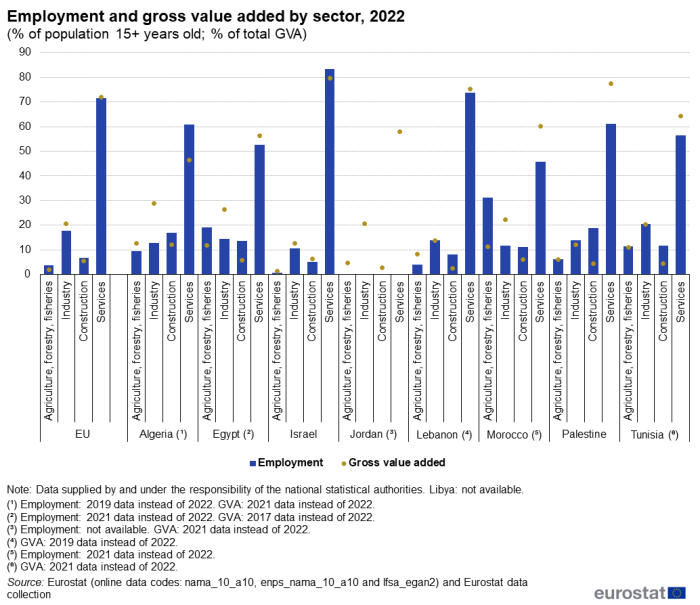
(% of population 15+ years old; % of total GVA)
Source: Eurostat (nama_10_a10), (enps_nama_a10), (lfsa_egan2) and Eurostat data collection.
Gross fixed capital formation
Gross fixed capital formation (GFCF) indicates how much the value added in an economy is invested rather than consumed. It is considered an indicator of future business activity. In general, GFCF tends to increase in times of economic growth and business confidence. Conversely, it tends to decrease in case of economic uncertainty or recession.
GFCF as a percentage of GDP in the period 2012 to 2022 is presented in Figure 4 for the ENP-South countries, compared with the EU. At the beginning of the period, in 2012, this percentage was very similar to the EU (20.3 %) in most of the ENP-South countries, ranging from 22.5 % in Tunisia to 25.3 % in Lebanon, with Israel, Palestine (both 23.3 %) and Jordan (24.3 %) also in this range. The countries with lower ratios between GFCF and GDP in 2012 were Egypt (14.7 %) and Libya (15.9 %) while the ratio was higher in Algeria (30.8 %).
Over time, the ratio of GFCF to GDP tends to fluctuate in most countries. The ratio may be influenced by disruptions such as local political events, conflicts and disasters, which may have short-term effects on GDP, but also longer-term effects on GFCF due to instability that affects security of investments and expectations of economic growth. For economies where the petroleum industry plays an important role, international events that influence current oil and gas prices and expectations for future prices trends may also be of importance. Several of the ENP-South countries, albeit not all, saw substantial falls in 2020 in connection with the Covid-19 pandemic and the associated economic effects of lockdowns, restrictions on international travel and tourism, as well as lower international demand for petroleum products.
Over the period 2012-2022, the ratio between GFCF and GDP was quite stable in Morocco, Palestine, Israel, Tunisia and Egypt. In Morocco, from 2014 to 2022 it moved within the range 25.9 % (2015) and 28.7 % (2016), with the ratio at 27.1 % in 2022. In Palestine, GFCF as percentage of GDP moved within the interval 21.5 % (2014) to 25.7 % (2018), ending the period at 25.2 % in 2022. In Israel, the fluctuations were even smaller, with the ratio moving between 21.0 % (2015) and 24.6 % in 2022, its highest level of the period. In Tunisia the ratio moved between 22.5 % (2012) and 19.4 % (2018), despite some minor year-on-year increases overall showing a slightly negative trend. However, in 2020, the ratio fell to 15.8 % and remained almost at the same level with 16.0 % in 2021. For Egypt, data are available for the period 2012-2017, with the rate laying between 12.4 % (2014) and 14.8 % (2017).
In Algeria there was a gradual increase in the GFCF as percentage of GDP, from 30.8 % in 2012 to 43.1 % in 2016, followed by a decrease to 34.6 % in 2020, with a recovery to 37.5 % in 2021. In Jordan decreases were observed between 2012 (24.3 %) and 2016 (20.0 %), followed by slight increases in 2017 and 2018. Following a fall to 18.4 % in 2019 and moderate growth to 18.9 % in 2020, the ratio increased strongly in 2021 to 22.2 %.
The ratio of GFCF to GDP was more volatile in Lebanon (2012-2020) where the ratio fluctuated moderately between 27.0 % (2013) and 21.4 % (2017) in the period up to 2018. However, in 2019 GFCF as percentage of GDP fell sharply to 13.6 %, down from 21.8 % the previous year, reflecting the Lebanon economic and financial crisis that began in October 2019. With the Covid-19 pandemic and the large explosion in the Port of Beirut in August 2020 causing further disruption, GFCF relative to GDP in Lebanon fell further to 12.5 % in 2020. In Libya, the stabilisation seen after the end of the civil war of 2011 ended in the middle of 2014, marking a renewed period if internal conflict. Despite this, the ratio of GFCF to GDP remained remarkably stable during 2012-2019, at between 15.8 % (2019) and 19.4 % (2016), with an outlier at 23.2 % in 2014.
In Tunisia, the ratio between GFCF and GDP decreased slightly from 22.5 % in 2012 to 20.3 % in 2014, with a slight rebound in 2015 to 21.0 % but resumed the steady decline to reach 19.4 % in 2019. It then decreased abruptly to 16.0 % in 2021.
In the EU, GFCF as share of GDP remained within the range 19.8 % (2013 and 2014) and 22.5 % (2022) over the period 2012-2022.

(% of GDP)
Source: Eurostat (nama_10_gdp) and Eurostat data collection.
External balance of trade in goods and services
The external balance of trade in goods and services is the difference between exports and imports of goods and services. This balance is important for sustainable GDP growth. Measured as a share of GDP, it is also an expression of the openness of the economy and its dependence on international trade. Figure 5 presents the external balance of trade in goods and services in the EU and in the ENP-South countries for the years 2017 and 2022. Data for Egypt, Jordan and Morocco are not available.
In 2017, in all ENP-South countries for which data are available, except Libya, the balances in trade of goods were negative, i.e., the value of imports of goods was higher than that of exports. The balances in trade of services, however, were not showing a consistent pattern. Whereas Israel, Lebanon and Tunisia had a positive balance in trade of services in 2017, i.e., meaning total exports were higher than total imports, Algeria, Libya and Palestine recorded negative balances in trade of services. The situation in 2022 had not changed materially compared to 2017 with respect to trade of goods, with only Algeria (2021 data) moving from a negative balance to a positive one, with the balance in Libya (2019 data) remaining positive and all other countries maintaining their negative balances. For services, Lebanon was the only country for which the balance changed, from a positive balance in 2017 to a slightly negative one in 2020, the most recent year for which data is available.
In Algeria, the negative balance in trade of goods in 2017, -6.6 % of GDP, turned into a positive balance of 1.5 % in 2021. Algeria's deficit in trade of services decreased from -3.4 % to -1.2 % over the same period. In Israel, the surplus in trade of services increased from 2017 to 2022, from 4.8 % to 7.9 %. However, the deficit for goods increased from -2.9 % to -5.0 %. In Lebanon, the balances deteriorated between 2017 and 2020 for both goods and services, with the already substantial deficit for goods widening from -27.5 % to -30.7 %, while the previous surplus of 2.9 % for services turned into a deficit of -0.5 %. Libya's balance in trade of goods improved from 12.9 % to 16.6 % between 2017 and 2019, while the deficit for services grew from -6.4 % to -10.4 %. Palestine remained the ENP-South country with the largest negative balance for goods, with its deficit increasing from -32.5 % in 2017 to -42.8 % in 2022. In contrast, its balance in trade of services improved from -2.4 % to -1.8 %. Whereas Tunisia's deficit for goods fell from -14.0 % in 2017 to -11.2 % in 2021, its surplus for services fell from 1.7 % to 1.1 % over the same period.
Between 2017 and 2022, the EU's balance for goods fell from a surplus of 2.5 % of GDP to a deficit of -1.2 %. Its surplus for services increased from 0.9 % to 1.3 %.
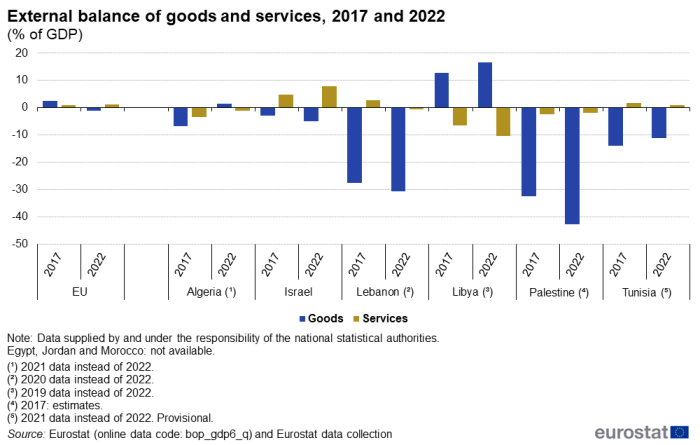
(% of GDP)
Source: Eurostat (bop_gdp6_q) and Eurostat data collection.
Foreign direct investment balance
Foreign direct investment (FDI) represents a lasting interest in an enterprise operating in another economy and implies the existence of a long-term relationship between the direct investor and the recipient enterprise. It forms a part of the financial account of the balance of payments. Inflows represent flows of investment into the economy; outflows represent flows of investment by the economy to the rest of the world. Negative values represent a reduction in the value of FDI in the economy; this may reflect transfer of ownership from foreign to domestic investors, revaluation of investments or other disinvestments. Countries that attract considerable inward investment are often themselves investors in other countries. The balance of inward and outward FDI flows is shown in Figure 6. As FDI may reflect large investments in specific projects within a limited timeframe, data values can vary greatly from one year to another. Data for Egypt, Jordan, Libya, and Palestine are not available.
Over the period 2012-2022, Israel was by far the ENP-South country with the largest net FDI flows into its economy, also reflecting its status as the largest economy among these countries. However, the net balance of FDI flows fluctuated considerably year-on-year, with net FDI inflows at €5-6 billion in 2012 and 2013, before falling year-on-year and turning into a net outflow of -€2.5 billion in 2016, before starting a cycle where net FDI inflows rose and fell year-on-year between €7-8 billion in 2017, 2019 and 2021 and €12-15 billion in 2018, 2020 and 2022. Overall, Israel's net annual FDI flows increased over the period, from €5.1 billion in 2012 to €12.1 billion in 2022.
Between 2012 and 2018, Morocco had a net annual FDI inflow fluctuating between €1.4 billion (2016 and 2017) and €2.4 billion (2014, 2015 and 2018). Thereafter, the balance began to fall, reaching lows at €0.7 billion in 2019 and €0.8 billion in 2020, before increasing back to €1.4 billion in 2021 and €1.5 billion in 2022. From a high of €1.2 billion in 2012, Tunisia's net FDI inflow stabilised in the range of €0.9 billion (2015) to €0.5 (2020 and 2021), ending the period with a net FDI inflow of €0.6 billion in 2022. Lebanon recorded relatively stable net FDI flows between 2012 and 2021, ranging from €1.1 billion (2017) to €1.7 billion (2018) per year, with 2013 an outlier (€0.5 billion). However, in 2022 net FDI inflow fell sharply to €0.4 billion. In Algeria, over the period 2012-2020 the net FDI balance generally fluctuated between inflows of €1.4 billion (2016) and €1.0 billion (2020), with the exceptions 2015 (net outflow -€0.6 billion) and 2018 (net inflow €0.5 billion). However, net inflows fell in the last two years, to €0.8 billion in 2021 and further to an almost complete balance of net inflows and outflows at €20 million in 2022.
In comparison, in the EU net FDI flows fluctuated strongly between net inflows and net outflows over the period 2013-2022. The highest net FDI inflows in this period were €51.7 billion in 2013, whereas high net FDI outflows were recorded in 2021 (-€415.6 billion), 2022 (-€325.7 billion), 2015 (€211.8 billion) and 2017 (-€200.6 billion).
Persons employed by public and private sector
Figure 7 presents the distribution of employment between the public (general government) and the private sector in the ENP-South countries, compared with the EU. The general government sector includes the central government, state government, local government and social security funds. Data refer to 2022, except for Morocco (2021 data) and Algeria (2019 data). Data for Jordan and Libya are not available.
Among the ENP-South countries, there is a certain difference in the labor market structure in this respect. Employment in Morocco was heavily concentrated in the private sector, with 90.8 % of persons employed working in the private sector and only 9.2 % in the public sector (2021 data). In most of the other ENP-South countries the public sector accounted for between 17 % and 25 % of employment, with Lebanon at 17.0%, Palestine at 19.8 %, Egypt at 21.9 %, Tunisia at 22.8 % and Israel at 25.1 %.
Algeria stood out with by far the largest public sector with respect to its share in total employment, which accounted for 37.8 % of persons employed (2019 data), with the private sector accounting for 62.2 %.
In the EU, the share of the public sector (defined as sections O-Q of NACE Rev.2) for total employment was 25.7 % in 2022.

(% of total persons employed aged 20-64)
Source: Eurostat (lfsa_egan2) and Eurostat data collection.alt= stapled bar chart to 100 per cent, showing the share of persons employed in the private sector and the public sector in the ENP-South countries Algeria, Egypt, Israel, Lebanon, Morocco, Palestine, Tunisia and the EU for the year 2022.
Source data for tables and graphs
Data sources
The data for ENP-South countries are supplied by and under the responsibility of the national statistical authorities of each country on a voluntary basis. The data that are presented in this article result from an annual data collection cycle that has been established by Eurostat. Cooperation with Syria is suspended since 2011. These statistics are available free-of-charge on Eurostat’s website, together with a range of different indicators covering most socio-economic areas.
The European system of national and regional accounts (ESA 2010) provides the methodology for national accounts in the EU. ESA 2010 is consistent with the worldwide guidelines for national accounts, the System for National Accounts (2008 SNA). The national accounts data presented in this article for ENP-South countries were either collected under 2008 SNA or ESA 2010.
The gross domestic product (GDP) is the central measure of national accounts, which summarises the economic position of a country (or region). It can be calculated using different approaches: the output approach; the expenditure approach; and the income approach. The main aggregates of national accounts are compiled from institutional units, namely non-financial or financial corporations, general government, households, and non-profit institutions serving households (NPISH).
The Balance of Payments (BoP is the central source for data on balance of trade in goods and services and on foreign direct investment (FDI) flows. BoP statistics are internationally harmonised based on the International Monetary Fund (IMF) Balance of Payments and International Investment Position Manual (BPM6). Some countries still apply the previous edition, BPM5.
Finally, data on employment and the labour market are based on the methodology laid down in the EU Labour Force Survey (LFS). The definitions used are based on international recommendations by the International Labour Organization (ILO).
Context
Indicators derived from national accounts provide a picture of the economic situation; they are widely used for analysis and forecasting, and provide the framework for government policy decisions. Foreign direct investment statistics provide a measure of the attractiveness of a country as an investment destination.
The use of internationally accepted concepts and definitions permits an analysis of different economies, such as the interdependencies between the economies of the EU Member States, or a comparison between the EU and non-member countries.
Within the EU, multilateral economic surveillance was introduced through the stability and growth pact, which provides for the coordination of fiscal policies. Economic and financial statistics have become one of the cornerstones of governance at a global and European level, for example, to analyse national economies during the global financial and economic crisis, economic recovery after the Covid-19 pandemic or to put in place EU initiatives such as the European semester, designed to promote discussions concerning economic and budgetary priorities, or the macroeconomic imbalance procedures (MIP).
The European Neighbourhood Policy (ENP), launched in 2003 and developed throughout 2004, supports and fosters stability, security and prosperity in the EU’s neighbourhood. The ENP was revised in 2015. The main principles of the revised policy are a tailored approach to partner countries; flexibility; joint ownership; greater involvement of EU member states and shared responsibility. The ENP aims to deepen engagement with civil society and social partners. It offers partner countries greater access to the EU's market and regulatory framework, standards and internal agencies and programmes.
The Joint Communication on Renewed Partnership with the Southern Neighbourhood – A new Agenda for the Mediterranean, accompanied by an Economic and Investment Plan for the Southern neighbours, of 9 February 2021 further guides cooperation with the ENP-South countries. Additional information on the policy context of the ENP is provided on the website of Directorate-General European Neighbourhood Policy and Enlargement Negotiations (DG NEAR).
In cooperation with its ENP partners, Eurostat has the responsibility to promote and implement the use of European and internationally recognised standards and methodology for the production of statistics, necessary for designing and monitoring policies in various areas. Eurostat manages and coordinates EU efforts to increase the capacity of the ENP countries to develop, produce and disseminate good quality data according to European and international standards.
Reliable and comparable data are essential for evidence-based decision-making. They are needed to monitor the implementation of the agreements between the EU and the ENP-South countries, the impact of policy interventions and the reaching of the Sustainable Development Goals (SDGs).
The main objective of Euro-Mediterranean cooperation in statistics is to enable the production and dissemination of reliable and comparable data, in line with European and international norms and standards.
The EU has been supporting statistical capacity building in the region for a number of years through bilateral and regional activities to strengthen statistical capacity. This takes the form of technical assistance to partner countries’ national statistical authorities through targeted assistance programmes, such as the MEDSTAT programme (currently in its fifth phase: MEDSTAT V (2022-2025)), and activities such as training courses, working groups and workshops, exchange of best practice and the transfer of statistical know-how.
Notes
- ↑ This designation shall not be construed as recognition of a State of Palestine and is without prejudice to the individual positions of the Member States on this issue.
Explore further
Other articles
Database
Thematic section
Publications
Books
Factsheets
- Basic figures on the European Neighbourhood Policy-South countries — 2022 edition
- Basic figures on the European Neighbourhood Policy-South countries — 2022 edition
- Basic figures on the European Neighbourhood Policy-South countries — 2021 edition
Leaflets
- Basic figures on the European Neighbourhood Policy — South countries — 2020 edition
- Basic figures on the European Neighbourhood Policy — South countries — 2019 edition
- Basic figures on the European Neighbourhood Policy — South countries — 2018 edition
- Basic figures on the European Neighbourhood Policy — South countries — 2016 edition
- Basic figures on the European Neighbourhood Policy — South countries — 2015 edition
- International trade in goods for the European neighbourhood policy-South countries — 2018 edition
Methodology
- Southern European Neighbourhood Policy countries (ENP-South) (enps) (ESMS metadata file — enps_esms)

